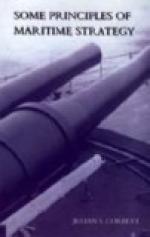Here again Togo’s practice was the reverse of the maxim.
The true maxim is “The primary object of the fleet is to secure communications, and if the enemy’s fleet is in a position to render them unsafe it must be put out of action.”
The enemy’s fleet usually is in this position, but not always.
EXAMPLE.—Opening of War of Spanish Succession. The operations of 1702 were to secure some point (Cadiz, Gibraltar, or Ferrol) on the Spanish trade communications, the French lateral communications, and our own lines of passage to the Mediterranean, where was to be our chief theatre of operation. These last two lines were identical. 1703.—Chief operations had for their object to secure the alliance of Savoy, and particularly of Portugal, and with same object in view, Rooke’s official instructions directed that the French fleet was to be ignored unless it threatened our communications.
RESULT.—By 1704
we had gained a Naval position from which France could
not eject us, and she abandoned
struggle for sea communications.
But nine times out of ten the maxim of seeking out the enemy’s fleet, &c., is sound and applicable:—
(a) Because for us general
permanent command is usually essential
to ultimate success, and this
cannot be obtained without destroying the
enemy’s fleet.
(b) Because usually the enemy’s
fleet opens with an attempt to
control the common communications.
(c) Because usually the functions of the fleet are so complex (i.e., the calls upon it so numerous) that it will seek to strike a blow which solve all the difficulties; e.g., Sir Palmes Fairborne’s solution of the problem in 1703 (England in the Mediterranean, Vol. II., p. 234).
Also it must be remembered that nine times out of ten the most effective way of “seeking out the enemy’s fleet” (i.e., forcing an action on him) is to seize a position which controls communications vital to his plan of campaign.
This was what happened in 1704. Rooke was unable to seek out the Toulon fleet, but by seizing Gibraltar he made it come to him (not intentionally, but by the operation of inevitable strategical law).
Compare Togo’s strategy and that of the Americans in 1898.
Practically all great Naval actions have been brought about in this way, that is they have been the outcome on an effort to clear essential communications from the enemy’s fleet, e.g., Gravelines, La Hogue, Quiberon, Trafalgar, Tsushima.
Similarly the great actions of the old Dutch wars were brought about because our geographical position placed us astride the Dutch trade communications, and they were forced to seek a decision against our fleet.
FINAL NOTE
In applying the maxim of “seeking out the enemy’s fleet” it should be borne in mind:—




